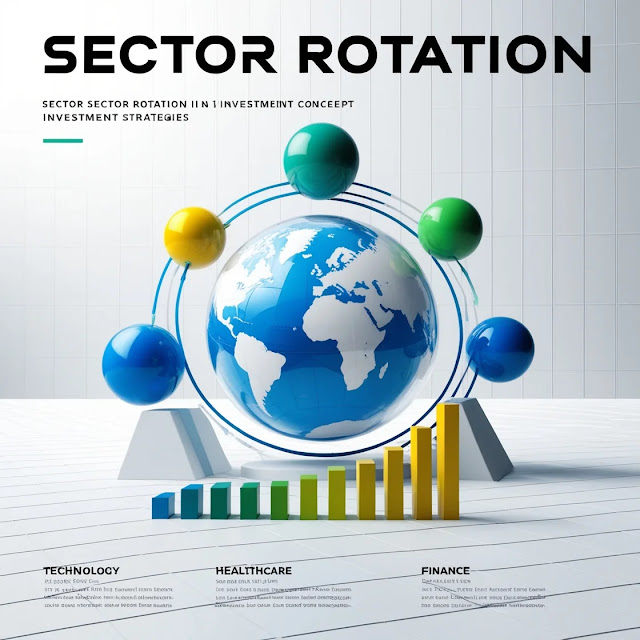The Role of Sector Rotation in Investment Strategies
In the complex world of investments, sector rotation plays a critical role in helping investors maximize returns while managing risk. Sector rotation, a strategic investment approach, involves shifting funds between different sectors based on economic cycles and market trends. This article delves into the importance of sector rotation in investment strategies, exploring how investors can use it to adapt to economic changes and achieve financial growth. Whether you’re new to investing or a seasoned investor, understanding sector rotation can help you make informed decisions and enhance your portfolio's performance.
 |
| The Role of Sector Rotation in Investment Strategies |
What is Sector Rotation?
Sector rotation is an investment strategy that involves reallocating assets across different sectors of the economy to capitalize on market cycles. By strategically shifting investments between sectors such as technology, healthcare, financials, and energy, investors aim to capture growth in sectors that are expected to outperform while avoiding sectors that may underperform during certain phases of the economic cycle. This approach can reduce risk and optimize returns over time.
Understanding Economic Cycles and Sector Performance
Sector rotation is closely linked to economic cycles, which typically follow stages such as expansion, peak, contraction, and trough. Each phase of the cycle impacts various sectors differently. For example, during periods of economic growth, sectors like technology and consumer discretionary may perform well, while defensive sectors like utilities and consumer staples tend to do better in downturns. Understanding these cycles allows investors to time their sector allocation more effectively, positioning themselves to benefit from sector-specific growth trends.
Why Sector Rotation is Important in Investment Strategies
Sector rotation is essential for investors seeking to optimize portfolio performance. By staying ahead of economic trends, investors can take advantage of sectors likely to outperform while reducing exposure to those facing downturns. This proactive approach not only enhances returns but also helps manage risk, as investments are diversified across sectors with varying performance correlations. Sector rotation enables investors to align their portfolios with the current and anticipated economic environment, thereby improving resilience against market volatility.
How to Implement Sector Rotation in Your Portfolio
Implementing sector rotation involves monitoring economic indicators and trends to anticipate sector performance. Investors can use tools like sector ETFs (exchange-traded funds) to gain exposure to specific sectors without individual stock selection. Analyzing factors such as interest rates, inflation, and global events can help investors identify when certain sectors might outperform. Regularly rebalancing the portfolio based on these insights is key to maintaining an effective sector rotation strategy.
Challenges and Risks of Sector Rotation
While sector rotation offers potential benefits, it also comes with risks. Timing the market accurately is challenging, and misjudging economic cycles can lead to losses. Additionally, frequent portfolio adjustments can incur transaction costs, which may erode returns over time. To mitigate these risks, investors should consider a disciplined approach, using research and analysis to guide their sector rotation decisions rather than reacting to short-term market fluctuations.
Successful Examples of Sector Rotation Strategies
Many successful investors and fund managers have implemented sector rotation strategies. For instance, during the COVID-19 pandemic, the healthcare and technology sectors performed well due to increased demand for medical and digital services. Conversely, sectors like travel and hospitality underperformed. Investors who rotated into tech and healthcare early on achieved significant gains. Learning from these examples can help investors recognize the importance of flexibility and awareness in sector rotation.
Common Questions about Sector Rotation
How often should I adjust my sector rotation strategy?
The frequency of adjustments depends on your investment goals and the economic cycle. Many investors review their sector allocation quarterly or semi-annually, though some may adjust more frequently based on market conditions. A long-term approach to sector rotation is typically more effective than attempting to time the market on a daily or weekly basis.
Is sector rotation suitable for all types of investors?
Sector rotation can benefit both novice and experienced investors, but it requires a good understanding of economic trends. Novice investors may prefer using sector ETFs or mutual funds managed by professionals, while more advanced investors might directly invest in individual stocks within selected sectors.
Can sector rotation help in a bear market?
Yes, sector rotation can provide a defensive strategy in a bear market by reallocating assets to sectors that typically perform well during downturns, such as utilities and consumer staples. This approach can help reduce losses and maintain portfolio stability during market declines.
What tools can help with sector rotation analysis?
Several tools and platforms, such as Bloomberg, Morningstar, and sector-specific ETFs, offer data and insights to assist with sector rotation. Financial advisors and market research can also provide guidance for investors who want to develop a robust sector rotation strategy.
Conclusion
In summary, sector rotation is a dynamic investment strategy that can enhance portfolio performance by capitalizing on economic cycles. By understanding the different phases of these cycles, investors can anticipate sector shifts and allocate assets accordingly, improving returns and managing risks. While sector rotation requires careful analysis and timing, the potential benefits make it a valuable approach for those looking to optimize their investment strategies. Embracing sector rotation with a disciplined approach can lead to long-term financial success and stability, especially in today’s ever-evolving economic landscape.





